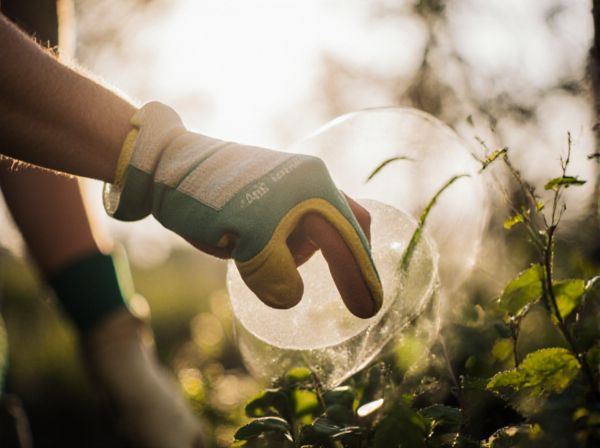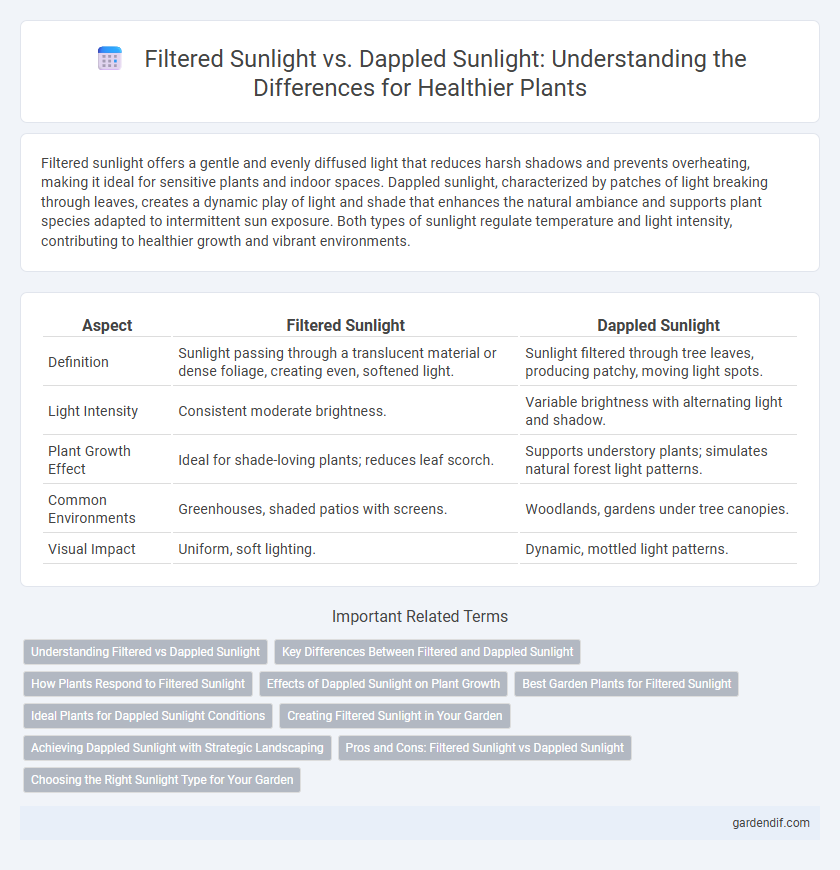
Filtered sunlight vs dappled sunlight Illustration
Filtered sunlight offers a gentle and evenly diffused light that reduces harsh shadows and prevents overheating, making it ideal for sensitive plants and indoor spaces. Dappled sunlight, characterized by patches of light breaking through leaves, creates a dynamic play of light and shade that enhances the natural ambiance and supports plant species adapted to intermittent sun exposure. Both types of sunlight regulate temperature and light intensity, contributing to healthier growth and vibrant environments.
Table of Comparison
| Aspect | Filtered Sunlight | Dappled Sunlight |
|---|---|---|
| Definition | Sunlight passing through a translucent material or dense foliage, creating even, softened light. | Sunlight filtered through tree leaves, producing patchy, moving light spots. |
| Light Intensity | Consistent moderate brightness. | Variable brightness with alternating light and shadow. |
| Plant Growth Effect | Ideal for shade-loving plants; reduces leaf scorch. | Supports understory plants; simulates natural forest light patterns. |
| Common Environments | Greenhouses, shaded patios with screens. | Woodlands, gardens under tree canopies. |
| Visual Impact | Uniform, soft lighting. | Dynamic, mottled light patterns. |
Understanding Filtered vs Dappled Sunlight
Filtered sunlight occurs when sunlight passes through a dense layer of leaves or a mesh, resulting in a steady, evenly diffused light ideal for shade-loving plants and delicate seedlings. Dappled sunlight features patches of light and shadow created by intermittent gaps in foliage, providing a dynamic light pattern beneficial for understory plants that thrive in fluctuating light conditions. Understanding the distinctions between filtered and dappled sunlight helps gardeners optimize plant placement and growth by matching species to their preferred light environment.
Key Differences Between Filtered and Dappled Sunlight
Filtered sunlight passes through a translucent medium such as a curtain or dense foliage, resulting in a softened, evenly distributed light that reduces glare and harsh shadows. Dappled sunlight occurs when sunlight filters through gaps in leaves or branches, creating irregular patches of light and shadow on surfaces below. Key differences include the uniformity and consistency of filtered light versus the dynamic, shifting patterns seen in dappled sunlight.
How Plants Respond to Filtered Sunlight
Plants exposed to filtered sunlight receive moderate light intensity that reduces the risk of leaf scorch while still enabling photosynthesis, promoting efficient growth and vibrant foliage. This soft light enhances chlorophyll production, boosting the plant's ability to convert light energy into biochemical energy without stress. Shade-tolerant species, such as ferns and begonias, thrive under filtered sunlight, optimizing water retention and nutrient use for healthier development.
Effects of Dappled Sunlight on Plant Growth
Dappled sunlight provides intermittent light patterns that reduce intensity and heat stress, promoting healthier photosynthesis in shade-tolerant plants. This filtered light environment enhances moisture retention in soil, aiding nutrient uptake and preventing leaf scorch common in full or filtered direct sunlight. As a result, plants exposed to dappled sunlight often exhibit improved leaf coloration, stronger stems, and balanced growth compared to those under harsh filtered sunlight conditions.
Best Garden Plants for Filtered Sunlight
Filtered sunlight provides a consistent, moderate light level ideal for shade-tolerant plants like ferns, hostas, and begonias, which thrive under a canopy of trees. Dappled sunlight, characterized by scattered patches of light and shadow, suits plants such as hydrangeas and impatiens that benefit from intermittent sunlight exposure. Selecting best garden plants for filtered sunlight involves choosing species adapted to lower light intensity and humidity conditions typically found under tree canopies or shaded patios.
Ideal Plants for Dappled Sunlight Conditions
Dappled sunlight provides intermittent light filtered through tree canopies, creating a mosaic of light and shade ideal for shade-tolerant plants such as ferns, hostas, and astilbes. These plants thrive in environments where direct sunlight is diffused, reducing the risk of leaf scorch while promoting healthy growth. Gardeners seeking vibrant foliage and delicate blooms should select species adapted to dappled sun to optimize photosynthesis and maintain moisture levels.
Creating Filtered Sunlight in Your Garden
Creating filtered sunlight in your garden involves using plants or structures to diffuse direct sunlight and reduce harsh shadows. Techniques such as installing shade cloths, placing latticework, or planting deciduous trees with light, airy foliage help produce gentle, evenly dispersed light. This type of filtered sunlight promotes healthier growth for shade-loving plants and maintains balanced moisture levels in the soil.
Achieving Dappled Sunlight with Strategic Landscaping
Achieving dappled sunlight through strategic landscaping involves planting trees or installing structures that partially block direct sunlight, creating a pattern of light and shade ideal for shade-tolerant plants. Using deciduous trees with a moderate canopy density allows filtered light to pass through, balancing sunlight exposure and preventing leaf scorch in sensitive plants. Incorporating pergolas with climbing vines or adjustable shade sails can further refine the light intensity, optimizing growth conditions and enhancing garden aesthetics.
Pros and Cons: Filtered Sunlight vs Dappled Sunlight
Filtered sunlight provides consistent, moderate light intensity ideal for shade-loving plants, reducing the risk of leaf scorch but potentially limiting growth in sun-reliant species. Dappled sunlight, characterized by intermittent light patches, enhances photosynthesis through dynamic light exposure but may cause uneven leaf development and stress for sensitive plants. Both light types influence plant health and garden design, with filtered sunlight favoring stability and dappled sunlight promoting diversity in light conditions.
Choosing the Right Sunlight Type for Your Garden
Filtered sunlight offers a consistent level of light intensity by passing through a medium such as a tree canopy or shade cloth, ideal for shade-loving plants like ferns and begonias. Dappled sunlight creates patchy light patterns with intermittent sun and shade, benefiting plants that require moderate light exposure, such as hydrangeas and hostas. Selecting between filtered and dappled sunlight depends on your garden's plant species needs and the desired light conditions to promote healthy growth and vibrant blooms.
Filtered sunlight vs dappled sunlight Infographic

 gardendif.com
gardendif.com